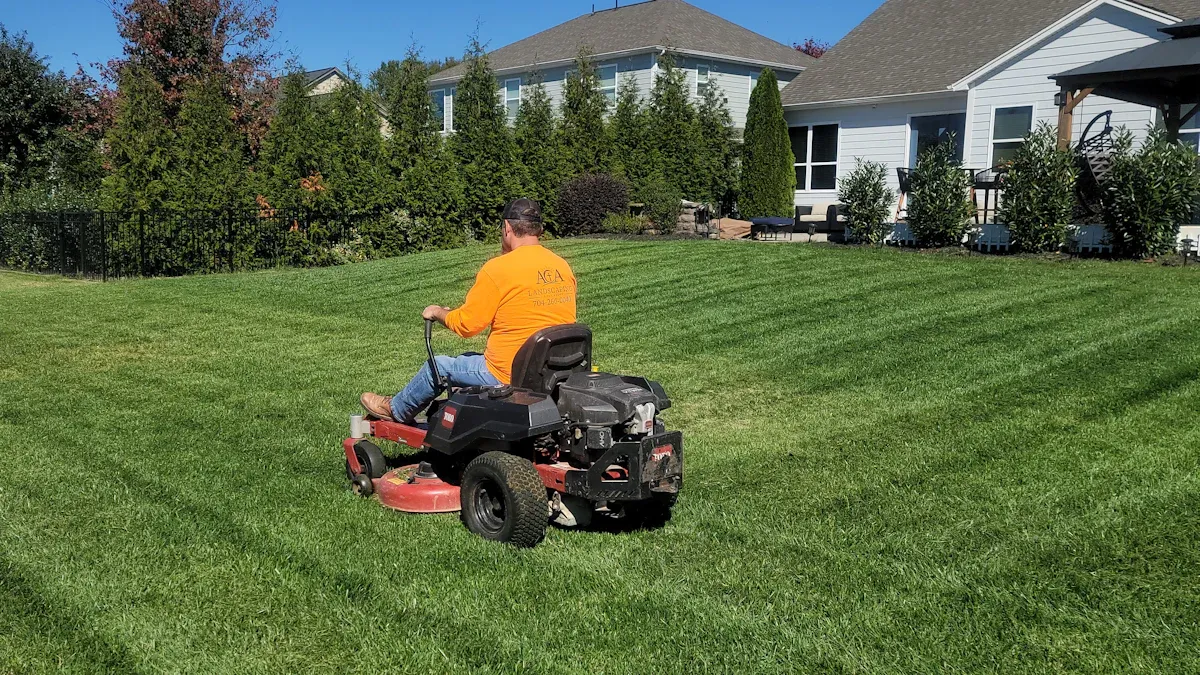Choosing the right trimmer line is key to keeping your yard looking sharp. A well-selected line boosts your trimming performance and makes the job easier. By understanding important factors, you can confidently choose the best trimmer line for your needs.
Key Takeaways
- Choose the right thickness for your trimmer line. Thicker lines handle tough jobs, while thinner lines are better for delicate tasks.
- Select the appropriate shape of trimmer line. Round lines are versatile, square lines cut tougher vegetation, and multi-sided lines offer a balance of both.
- Always check your trimmer’s manual for compatibility. Using the right line ensures optimal performance and prevents damage to your equipment.
Key Features of Trimmer Line
When it comes to selecting the right trimmer line, understanding its key features can make a big difference in your yard maintenance. Let’s break down the three main features: thickness, shape, and material.
Thickness
The thickness of your trimmer line plays a crucial role in how well it performs. Thicker lines are generally more durable and can handle tougher jobs, like cutting through thick weeds or heavy grass. If you have a lot of overgrown areas in your yard, you might want to opt for a thicker line, typically ranging from 0.095 to 0.155 inches in diameter.
On the other hand, thinner lines are better for lighter tasks, such as trimming around flower beds or sidewalks. They can provide a cleaner cut and are less likely to damage delicate plants. A line thickness of 0.065 to 0.080 inches is often sufficient for these lighter jobs.
Tip: Always check your trimmer’s manual to see the recommended line thickness. Using a line that’s too thick can strain your trimmer and lead to damage.
Shape
The shape of the trimmer line also affects its cutting efficiency. Here are the common shapes you’ll encounter:
- Round: This is the most common shape. It’s versatile and works well for general trimming tasks. Round lines are great for cutting grass and light weeds.
- Square: Square lines have sharper edges, which allows them to cut through tougher vegetation more effectively. If you’re dealing with thick weeds or brush, a square line might be your best bet.
- Multi-Sided: These lines combine the benefits of both round and square shapes. They offer excellent cutting power while maintaining versatility for various tasks.
Choosing the right shape can enhance your trimming experience and help you tackle different types of vegetation in your yard.
Material
The material of the trimmer line is another important factor to consider. Most trimmer lines are made from nylon, which is durable and flexible. However, there are variations in quality:
- Standard Nylon: This is the most common material. It’s suitable for everyday use and works well for most trimming tasks.
- Nylon with Added Features: Some lines come with added features, like a co-polymer blend, which increases durability and reduces breakage. These lines are ideal for heavy-duty jobs.
- Specialty Lines: You might also find lines designed for specific tasks, such as those with reinforced edges for cutting through tough brush or lines that are designed to reduce noise.
Choosing the right material can significantly impact the performance and longevity of your trimmer line.
By understanding these key features—thickness, shape, and material—you can select a trimmer line that meets your specific yard maintenance needs.
Types of Trimmer Line
When it comes to trimmer line, you have several options to choose from. Each type has its own strengths, so let’s explore the differences between round, square, multi-sided, and specialty lines.
Round vs. Square
Round trimmer line is the most common choice. It’s versatile and works well for general trimming tasks. You can use it for cutting grass and light weeds without any issues. On the other hand, square trimmer line has sharper edges. This design allows it to slice through tougher vegetation more effectively. If you often deal with thick weeds or brush, consider switching to a square line for better performance.
Multi-Sided Lines
Multi-sided lines combine the best features of both round and square lines. They offer excellent cutting power while still being versatile enough for various tasks. You’ll find that these lines can handle different types of vegetation, making them a great all-around choice for your yard maintenance.
Specialty Lines
Specialty lines are designed for specific tasks. For example, some lines come with reinforced edges to tackle tough brush, while others are made to reduce noise during operation. If you have unique trimming needs, look for a specialty line that fits your requirements.
Choosing the right type of trimmer line can make a significant difference in how efficiently you maintain your yard.
Trimmer Line Compatibility
Choosing the right trimmer line isn’t just about thickness or shape; it’s also about compatibility with your trimmer. You want to ensure that the line you select works well with your specific equipment. Let’s dive into how to match your line to your trimmer specifications, the differences between electric and gas trimmers, and why you should pay attention to manufacturer recommendations.
Matching Line to Trimmer Specifications
Every trimmer has its own specifications, and matching your trimmer line to these is essential. Here are some key points to consider:
- Check the Manual: Your trimmer’s manual will provide specific details about the recommended line diameter and type. Following these guidelines helps prevent damage to your trimmer.
- Spool Size: Make sure the line fits the spool of your trimmer. If the line is too thick, it may not fit properly, causing jams or even breaking the spool.
- Feed System: Some trimmers use automatic feed systems, while others require manual feeding. Ensure your line is compatible with your trimmer’s feeding mechanism for smooth operation.
By paying attention to these specifications, you can avoid frustrating issues and keep your yard looking great.
Electric vs. Gas Trimmers
When it comes to trimmers, you’ll typically find two main types: electric and gas. Each type has its own strengths and weaknesses, which can influence your choice of trimmer line.
- Electric Trimmers: These are usually lighter and quieter. They work best with thinner lines, typically ranging from 0.065 to 0.095 inches. If you have a small yard with light vegetation, an electric trimmer paired with a suitable trimmer line can make your job easier.
- Gas Trimmers: These are more powerful and can handle tougher jobs. They often require thicker lines, usually between 0.095 and 0.155 inches. If you’re dealing with heavy weeds or brush, a gas trimmer with the right trimmer line will help you tackle those challenges effectively.
Understanding the differences between electric and gas trimmers can guide you in selecting the right line for your needs.
Manufacturer Recommendations
Don’t overlook the importance of manufacturer recommendations. Each brand may have specific lines that work best with their trimmers. Here’s why you should consider these recommendations:
- Performance: Manufacturers design their trimmers to work optimally with certain lines. Using the recommended trimmer line can enhance performance and efficiency.
- Warranty: If you use a line that isn’t recommended, you might void your warranty. Always check the manufacturer’s guidelines to protect your investment.
- Quality Assurance: Manufacturer-approved lines often undergo testing to ensure they meet performance standards. This means you can trust that they’ll work well with your trimmer.
By following these recommendations, you can ensure that your trimmer operates smoothly and efficiently.
Trimmer Line Maintenance and Storage
Proper Storage Techniques
Storing your trimmer line properly can extend its life and keep it ready for action. Here are some tips to help you out:
- Keep it Dry: Moisture can weaken the line and lead to breakage. Store your line in a cool, dry place.
- Avoid Sunlight: UV rays can degrade the material. Use a storage container or a shaded area to protect it.
- Coil Neatly: If you have leftover line, coil it neatly to prevent tangling. You can use a piece of cardboard or a spool to keep it organized.
Tip: Consider labeling your storage container. This way, you’ll know exactly what type of line you have on hand.
Regular Maintenance Practices
Maintaining your trimmer line is just as important as storing it. Here are some easy practices to follow:
- Inspect Regularly: Check your line for wear and tear before each use. Look for frays or breaks that could affect performance.
- Replace When Needed: If your line shows signs of damage, replace it. Using a worn line can lead to poor cutting and more work for you.
- Clean Your Trimmer: After each use, clean the trimmer head. Grass and debris can build up and affect how well the line feeds.
By following these storage and maintenance tips, you’ll keep your trimmer line in top shape. This means less hassle and more time enjoying your beautifully maintained yard!
Choosing the right trimmer line is essential for effective yard maintenance. Remember to consider thickness, shape, and material. Also, ensure compatibility with your trimmer type. Take your time to explore options. A well-informed choice will make your trimming tasks easier and more enjoyable!
Post time: Oct-09-2025










